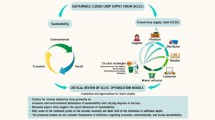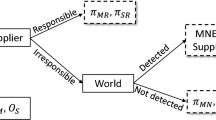Abstract
Quantity discounts are a useful mechanism for coordination. Here we investigate such discounts from the supplier's perspective, both from a non-cooperative game-theoretical approach and a joint decision model. Taking into account the price elasticity of demand, this analysis aids a sole supplier in establishing an all-unit quantity discount policy in light of the buyer's best reaction. The Stackelberg equilibrium and Pareto optimal solution set are derived for the non-cooperative and joint-decision cases, respectively. Our research indicates that channel efficiency can be improved significantly if the quantity discount decision is made jointly rather than non-cooperatively. Moreover, we extend our model in three directions: (1) the product is transported by a private fleet; (2) the buyer may choose to offer her customers a different percentage discount than that she obtained from the supplier; and (3) the case of heterogeneous buyers. Numerical case studies are employed throughout the paper to illustrate the practical applications of the models presented and the sensitivity to model parameters.








Similar content being viewed by others
References
Banerjee A (1986). Note on “A quantity discount pricing model to increase vendor profits”. Mngt Sci 32 (11): 1513–1517.
Chakravarty AK and Martin GE (1988). An optimal joint buyer-seller discount pricing model. Comput Opl Res 15: 271–281.
Chakravarty AK and Martin GE (1991). Operational economies of a process positioning determinant. Comput Opl Res 18: 515–530.
Chiang W-C, Fitzsimmons J, Huang Z and Li SX (1994). A game-theoretic approach to quantity discount problems. Decis Sci 25 (1): 153–168.
Choi SC, Lei L and Wang Q (2005). Quantity discounts for supply chain coordination. In: Chakravarty AK and Eliashberg J (eds). Managing Business Interfaces: Marketing and Engineering Issues in the Supply Chain and Internet Domains. Springer: New York, pp 133–171.
Cohon JL (1978). Multiobjective Programming and Planning. Academic Press: New York.
Dada M and Srikanth KN (1987). Pricing policies for quantity discounts. Mngt Sci 33 (10): 1247–1252.
Dolan RJ (1978). A normative model of industrial buyer response to quantity discounts. In: Jain SC (ed). Research Frontiers in Marketing: Dialogues and Directions. American Marketing Association: Chicago, pp 121–125.
Gibbons R (1992). Game Theory for Applied Economists. Princeton University Press: Princeton, NJ.
Joglekar PN (1988). Note—Comments on “A quantity discount pricing model to increase vendor profits”. Mngt Sci 34 (11): 1391–1398.
Kohli R and Park H (1989). A cooperative game theory model of quantity discounts. Mngt Sci 35 (6): 693–707.
Lal R and Staelin R (1984). An approach for developing an optimal discount pricing policy. Mngt Sci 30 (12): 1524(1516)–1540.
Lau AHL, Lau H-S and Wang J-C (2007). Pricing and volume discounting for a dominant retailer with uncertain manufacturing cost information. Eur J Opl Res 183 (2): 848–870.
Lee HL and Rosenblatt MJ (1986). A generalized quantity discount pricing model to increase supplier's profits. Mngt Sci 32 (9): 1177–1185.
Li X and Wang Q (2007). Coordination mechanisms of supply chain systems. Eur J Opl Res 179 (1): 1–16.
Monahan JP (1984). A quantity discount pricing model to increase vendor profits. Mngt Sci 30 (6): 720–726.
Parlar M and Wang Q (1994). Discounting decisions in a supplier-buyer relationship with a linear buyer's demand. IIE Trans 26 (2): 34–41.
Qin Y, Tang H and Guo C (2007). Channel coordination and volume discounts with price-sensitive demand. Int J Prod Econ 105 (1): 43–53.
Rubin PA and Benton WC (2003). A generalized framework for quantity discount pricing schedules. Decis Sci 34 (1): 173–187.
Stackelberg H von (1934). Market Form und Gleichgewicht. Springer: Berlin.
Viswanathan S and Wang Q (2003). Discount pricing decisions in distribution channels with price-sensitive demand. Eur J Opl Res 149 (3): 571–587.
Wang Q (1997). Determination of suppliers' optimal quantity discount schedules with heterogeneous buyers. Technical Report. Nanyang Business School, Nanyang Technological University, Singapore.
Wang Q (2002). Determination of suppliers’ optimal quantity discount schedules with heterogeneous buyers. Nav Res Logist 49 (1): 46–59.
Wang Q and Wang R (2005). Quantity discount pricing policies for heterogeneous retailers with price sensitive demand. Nav Res Logist 52 (7): 645–658.
Yang S-L and Zhou Y-W (2006). Unified discount pricing models of a two-echelon channel with a monopolistic manufacturer and heterogeneous retailers. Int Trans Opl Res 13 (2): 143–168.
Zhou Y-W (2007). A comparison of different quantity discount pricing policies in a two-echelon channel with stochastic and asymmetric demand information. Eur J Opl Res 181 (2): 686–703.
Author information
Authors and Affiliations
Corresponding author
Rights and permissions
About this article
Cite this article
Ke, G., Bookbinder, J. The optimal quantity discount that a supplier should offer. J Oper Res Soc 63, 354–367 (2012). https://doi.org/10.1057/jors.2011.35
Received:
Accepted:
Published:
Issue Date:
DOI: https://doi.org/10.1057/jors.2011.35




